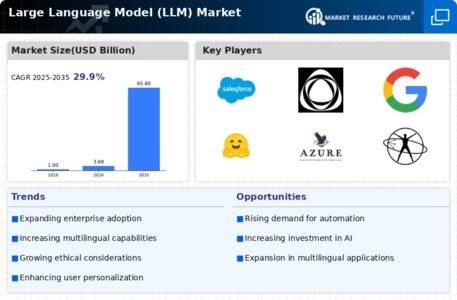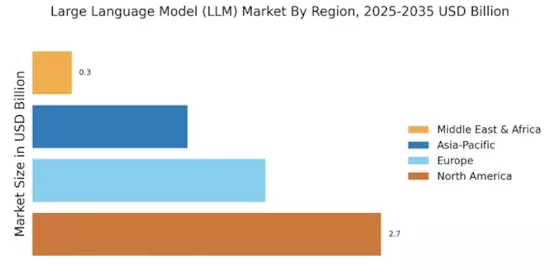Rising Demand for Automation
The Large Language Model Market (LLM) Market is experiencing a notable surge in demand for automation across various sectors. Organizations are increasingly leveraging LLMs to streamline operations, enhance productivity, and reduce human error. This trend is particularly evident in industries such as finance, healthcare, and customer service, where LLMs facilitate tasks ranging from data analysis to customer interaction. According to recent estimates, the automation market is projected to reach a valuation of over 200 billion dollars by 2026, indicating a robust growth trajectory. As businesses seek to optimize their processes, the integration of LLMs is likely to become a cornerstone of operational efficiency, thereby driving further investment in the LLM Market.
Emergence of Multimodal Models
The emergence of multimodal models is reshaping the landscape of the Large Language Model Market (LLM) Market. These models, which integrate text, image, and audio data, are enabling more comprehensive understanding and generation of content. As industries seek to create more interactive and engaging user experiences, the demand for multimodal capabilities is on the rise. This trend is particularly relevant in sectors such as gaming, virtual reality, and education, where diverse forms of content are essential. The market for multimodal AI is projected to grow significantly, with estimates suggesting a potential market size of over 50 billion dollars by 2027. As multimodal models gain traction, they are expected to drive innovation and expansion within the LLM Market.
Growing Investment in AI Research
The Large Language Model Market (LLM) Market is witnessing a surge in investment directed towards artificial intelligence research and development. Governments and private entities are recognizing the transformative potential of LLMs and are allocating substantial resources to foster innovation in this domain. For instance, funding for AI initiatives has seen a significant increase, with estimates suggesting that global investment in AI could exceed 500 billion dollars by 2025. This influx of capital is likely to accelerate advancements in LLM technologies, enabling the creation of more powerful and efficient models. As research progresses, the LLM Market stands to benefit from enhanced capabilities and broader applications, further solidifying its importance in the tech ecosystem.
Increased Focus on Personalization
Personalization is becoming a critical driver in the Large Language Model Market (LLM) Market, as businesses strive to deliver tailored experiences to their customers. LLMs are increasingly utilized to analyze user data and generate personalized content, recommendations, and interactions. This trend is particularly prominent in sectors such as e-commerce, entertainment, and marketing, where understanding consumer preferences is paramount. Research indicates that companies employing personalized marketing strategies can see conversion rates increase by up to 10 times. As organizations recognize the value of personalized engagement, the demand for LLMs that can effectively process and interpret vast amounts of data is likely to grow, thereby propelling the LLM Market forward.
Advancements in Natural Language Processing
Advancements in natural language processing (NLP) technologies are significantly influencing the Large Language Model Market (LLM) Market. Innovations in machine learning algorithms and neural networks have led to the development of more sophisticated LLMs capable of understanding and generating human-like text. This evolution is not only enhancing user experience but also expanding the applicability of LLMs in diverse fields such as education, content creation, and legal services. The NLP market is anticipated to grow at a compound annual growth rate of approximately 20%, reflecting the increasing reliance on LLMs for effective communication and information retrieval. As these technologies continue to mature, they are expected to play a pivotal role in shaping the future landscape of the LLM Market.


















Leave a Comment